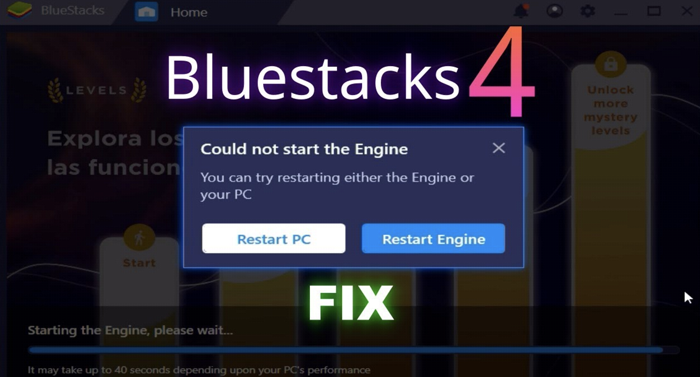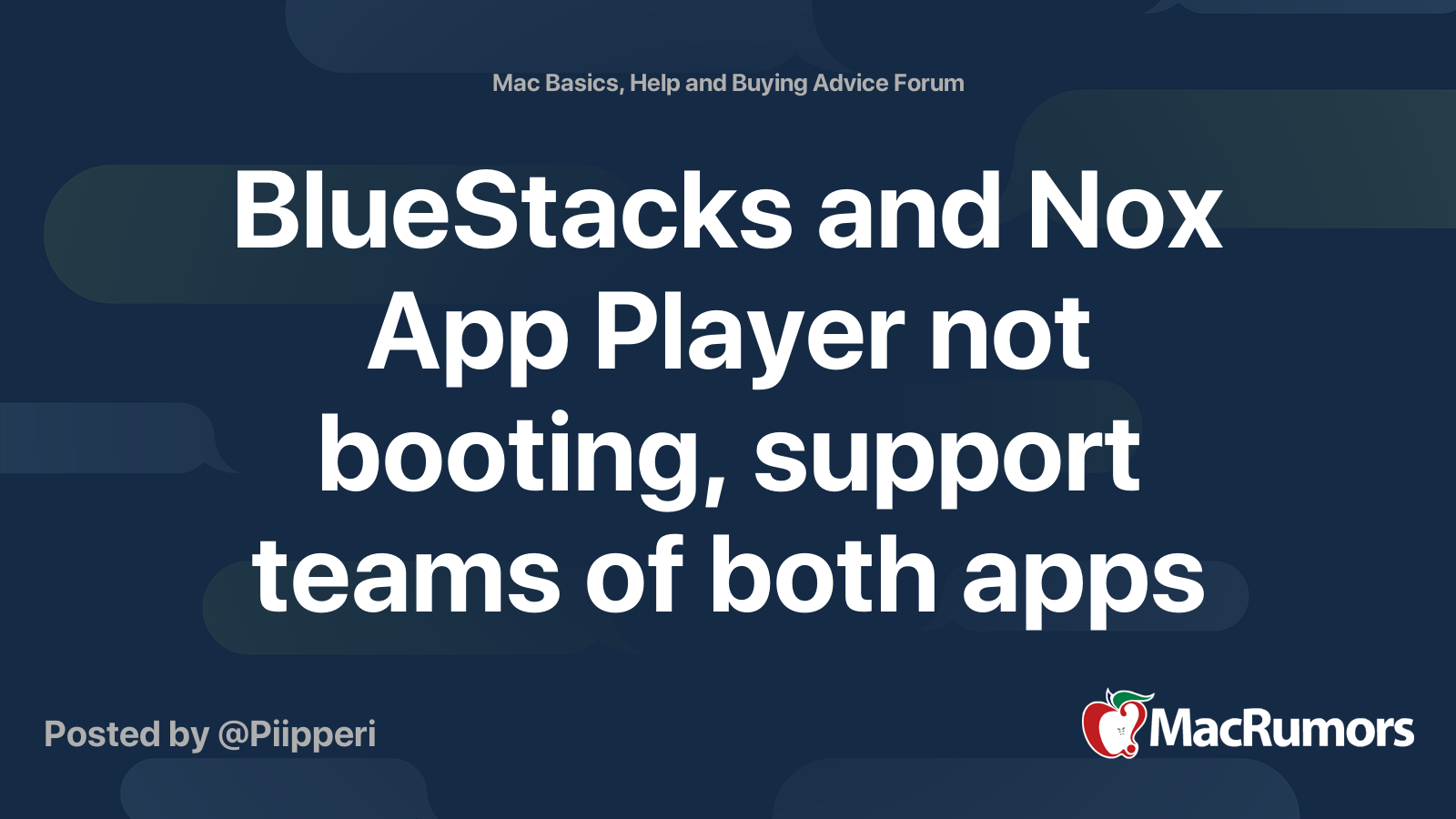Bluestacks 5 won't work anymore unless you enable this driver again and restart. I can say for sure that Riot Vanguard did not detect PROCEXP113.SYS to be running, so if you don't want to uninstall Bluestacks yet but want to play games with anti-cheat, you can probably do this to temporarily disable it. Mar 12, 2021 Bluestacks gets stuck in a loop with a “Could not start the Engine. You can try restarting the Engine or your PC” message endlessly showing upon launch with no fix in sight — frustrating to say the least. In this guide, we cover a handful of fixes to resolve this issue for good and improve Bluestacks’ performance overall. 100% Working guide to Fix Bluestacks Could Not Start the Engine issue on Windows 10, Windows 10 and MAC OS. Follow these steps to fix Bluestacks Engine issue easily. May 02, 2019 Fix: Bluestacks Engine Won’t Start Method 1: Switch to DirectX and change RAM capacity. In the engine settings of BlueStacks, you will have an option of. Method 2: Enable Virtualization Technology. Making sure that the Virtualization is enabled on your PC also helps in. Method 3: Completely. I had a previous version of bluestacks which was working well, till one day, when I was playing a game it kept closing. So I uninstalled that version, and went to www.bluestacks.com to re-install it.
BlueStacks is a versatile program which bridges the gap between desktops and mobiles since it allows users to run the Android applications on their Mac or Windows computer. With the help of the “Cloud Connect” feature, you can push applications from BlueStacks to any Android device and vice versa. Since it introduction in the year 2011, its popularity has grown and it can be downloaded for free in its recent beta form.
How to download and Install BlueStacks
Download BlueStacks offline installer from their official website. The application is compatible with the Mac OS X and Windows operating systems. Keep in mind that it will be installed in your boot drive. But you can choose to either get notification or not. If you experience problem with BlueStacks installation then go to this link to find some solutions.
The Home Screen
After it is installed, one can access the installed application by looking up at the “Top Charts,” and look for applications and access the settings since it boots to its Home Screen. The mouse can be used for normal touch controls by clicking and holding in order to initiate basic swipe and tap controls.
Bluestacks Game Won't Open
Some kind of set up has to be done prior to installing applications. First you have to establish your access to the Google Play store by adding a gmail account in order to make BlueStacks work.
Setting up the App Store
You need to link the application with your Google Account if you need to download applications from the Google Play store. Access ‘’My Apps’’ then select on “1-Click Sync Setup,” which will bring up some wizard interface which will offer the needed guidance. One has the option of using an existence Google account or establishing a new one.
Setting up BlueStacks Cloud Connect
Setting up BlueStacks Cloud Connect is an optional step for those using it with a tablet or Android Smartphone. This is an application which allows the users to push from the BlueStacks to his or her Android device and vice versa. The BlueStacks Cloud Connect should be downloaded for the device to be used and with the help of the setting button within the BlueStacks interface one should click on “Cloud Connect”.
Instructions of connecting to Bluestacks via your phone in order to push application and sync SMS will then be sent by SMS and email address.
At this point you can push applications between BlueStacks and the used device.
Running and Installing Apps
The built-in App Search should be used when searching and installing applications from 1Mobile, Amazon, Google Play for those not interested in synchronizing applications to and from any Android device. Though it seems complex at first, BlueStacks never lets you access its three inbuilt application markets directly. You have to use the app search to find the applications you want to install. By typing in the name of the Application you are searching for, it will search Google Play, Amazon and 1 Mobile matches and provides the available applications for installation from these stores.
After accessing one of the three application stores, the store can then be navigated. Within Amazon for example, the store’s search and various features can be taken advantage of.
The new application is ready to run once the user has returned to the Home Screen. A variety of applications can be run by BlueStacks which originate from multimedia and social networking tools. Not everything is compatible with BlueStacks, so you might get some errors.

Settings and controls
This far everything that is needed for installing and running applications from BlueStacks has been provided. Here, additional settings and in-app controls are provided. Unless you are running a windows 8 tablet or touch screen rig , you will be in need of tilt and pinch to zoom controls.
Pinch to Zoom: Control – or Control +.
Tilt Controls: ‘X’ or ‘Z’ or may be employed when you need to tilt your device right or left.
Bluestacks Not Booting Mac Os

Game-pad controls are compatible with BlueStacks for most of its applications. This offers valuable assistance for those who have the passion of playing Android games on their computers. The controller is plugged in and then the user is prompted by Bluestacks whether it is compatible or not. The settings menu has assorted keyboard settings, account management, contact, language setting as well as an application manager to install apps and set their default sizes.
If you have any question regarding BlueStacks don’t hesitate to ask using the comment field given bellow. Check this link for solution to common BlueStacks problems.
Testing Android applications on PC or Mac without a physical device can be quite a burden. The configurable Android virtual machines in Eclipse/Android Studio are notably sluggish and don't work well with many third party frameworks, especially those powered by C++. If your development machine has Intel-based hardware you can accelerate the emulation process by using Intel® HAXM technology, but AMD users are not yet so lucky.
The fastest and easiest way I've found to test Android applications is via the BlueStacks app player. BlueStacks is a free, ad-supported product for PC and Mac that enables you to download and run Android applications from your PC, as if using an Android device itself. BlueStacks isn't the only product on the market of its kind, but it does boast higher compatibility and a greater feature set than the competitors. According to BlueStack's feature chart, it supports up to 96% of all apps and 86% of all games on the Android market. Furthermore, BlueStacks offers streamlined emulation of the Android device's camera, microphone, multitouch and more which makes it ideal for testing in-development apps.
Installing Android Debug Bridge (ADB)
To use BlueStacks for debugging Android apps, you'll want to make sure you have the Android Debug Bridge (ADB) installed and operational. Some unofficial packages exist to get ADB in a hurry, but I have not tested said packages personally and it is easy enough to get it up and running through official means.

- If you haven't already done so, download and install the Android SDK Tools package from Google. ZIP files are offered for Windows, Mac and Linux; extract the contents to a dedicated directory.
- From the extracted file location, launch SDK Manager.exe. Under Tools, check the box to install 'Android SDK Platform-tools' and press the Install button. You will then have to click 'Accept License' and then 'Install' to download and install these components.
Android Debug Bridge (ADB) is part of Android's SDK Platform-Tools component.
- Once installed, you will find ADB.exe within the 'platform-tools' subfolder of the location you extracted the original files to. You can run this file from the command prompt without any parameters, or visit its official page on Google, to review the multitude of available settings. I recommend that you also append the ADB location to the PATH environmental variable [assuming it is a Windows install] so that it can be ran from any command line prompt without having to navigate into the folder directly.
- Press Windows Key + Pause/Break on your keyboard to get to the System Information screen.
- Click on Advanced System Settings in the left menu.
- Click the Environment Variables button.
- Double click the Path entry under System Variables.
- Go to the end of the field and make sure there is a semicolon (;), then insert the full platform-tools path (i.e., C:android-sdkplatform-tools)
- Click OK three times to close out of the dialog windows.
- Now if you have a physical Android device attached to your computer (with USB Debugging enabled), you should be able to type ADB devices from the command prompt to see a list of available devices for testing [the ADB daemon will start automatically with this command if it is not already started].
A list of connected Android devices accessible via ADB.
Installing BlueStacks App Player

Installing and configuring BlueStacks is as easy as installing any computer application.
- Head on over to http://www.bluestacks.com/ and click the Download button, which will match your target platform (Mac or Windows).
- Once downloaded, launch the EXE and follow standard install procedure on Windows, or double-click/drag the app file to your Applications folder on Mac.
- When you first launch BlueStacks, you will be taken through an initial configuration screen much like when booting a new Android tablet.
- You will want to sign-in using a Google account in order to access the Google Play store and synchronize app data and settings.
- When all is said and done, you'll be at a landing page with easy access to your Android applications.
Running Development Apps Through BlueStacks
With ADB and BlueStacks installed, all that remains is to connect ADB to the BlueStacks player and send your Android app to it. Note that the free version of BlueStacks is ad/app supported so you may occasionally be prompted to install promoted apps before continuing. Alternatively, you can buy a year-long license for $24, the full version can also enhance performance.

- Launch BlueStacks so that the main dashboard screen is visible.
- Open a command prompt (or terminal on Mac) and enter: adb connect 127.0.0.1 then press Enter. This will connect the BlueStacks player as a device on port 5555 by default. If the ADB command does not work, chances are you didn't set your path variable correctly; you can navigate to the platform-tools folder and run the adb command from there instead.
- From within Eclipse or Android Studio, click the Run or Debug button. This should open up the Android Device Chooser window where you will see the BlueStacks player and any other physical devices connected to the computer. Select the correct option and hit OK. The app should transfer to BlueStacks very quickly and will run much more fluidly than the default virtual machines!
Note that the BlueStacks player has been identified as a Samsung SM-G900F.
Happy coding!